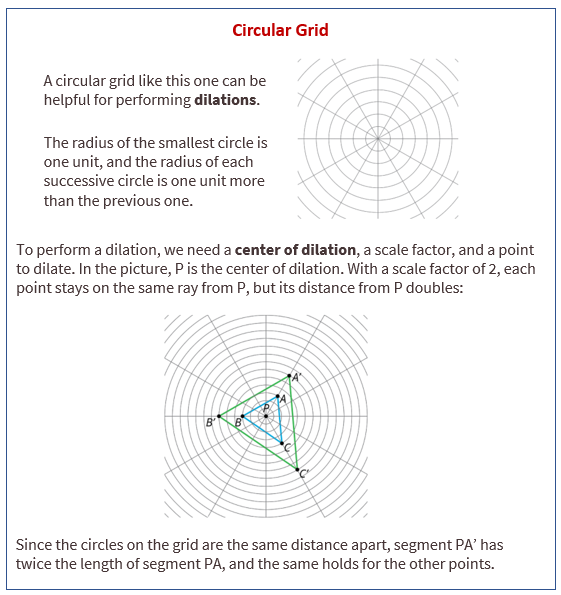Illustrative Mathematics Grade 8, Unit 2, Lesson 2: Circular Grid
Learning Targets:
- I can apply dilations to figures on a circular grid when the center of dilation is the center of the grid.
Related Pages
Illustrative Math
Grade 8
Lesson 2: Circular Grid
Let’s dilate figures on circular grids.
Illustrative Math Unit 8.2, Lesson 2 (printable worksheets)
Lesson 2 Summary
The following diagram shows how to apply dilations to figures on a circular grid when the center of dilation is the center of the grid.

Lesson 2.1 Notice and Wonder: Concentric Circles
What do you notice? What do you wonder?
Lesson 2.2 A Droplet on the Surface
The larger circle d is a dilation of the smaller circle c. P is the center of dilation.
- Draw four points on the smaller circle using the Point on Object tool.
- Draw the rays from through each of those four points. Select the Ray tool, then point , and then the second point.
- Mark the intersection points of the rays and circle d by selecting the Intersect tool and clicking on the point of intersection.
Open Applet - Complete the table. In the row labeled S, write the distance between P and the point on the smaller circle in grid units. In the row labeled L, write the distance between P and the corresponding point on the larger circle in grid units. Measure the distances between pairs of points by selecting the Distance tool, and then clicking on the two points.
- The center of dilation is point P. What is the scale factor that takes the smaller circle to the larger circle? Explain your reasoning.
Lesson 2.3 Scaled Rectangles
- Dilate each vertex of polygon ABCD using P as the center of dilation and a scale factor of 2.
Open Applet
- Draw segments between the dilated points to create a new polygon.
- What are some things you notice about the new polygon?
- Choose a few more points on the sides of the original polygon and transform them using the same dilation. What do you notice?
- Dilate each vertex of polygon ABCD using P as the center of dilation and a scale factor of .
- What do you notice about this new polygon?
Are you ready for more?
Suppose P is a point not on line segment WX. Let YZ be the dilation of line segment WX using P as the center with scale factor 2. Experiment using a circular grid to make predictions about whether each of the following statements must be true, might be true, or must be false.
- YZ is twice as long WX.
- YZ is five units longer than WX.
- The point P is on YZ.
- YZ and WX intersect.
Lesson 2.4 A Quadrilateral and Concentric Circles
- Dilate polygon EFGH using Q as the center of dilation and a scale factor of 1/3. The image of F is already shown on the diagram. (You may need to draw more rays from Q in order to find the images of other points.)
Open Applet
Lesson 2 Practice Problems
- Here are Circles c and d. Point O is the center of dilation, and the dilation takes Circle c to Circle d.
a. Plot a point on Circle c. Label the point P. Plot where P goes when the dilation is applied.
b. Plot a point on Circle d. Label the point Q. Plot a point that the dilation takes to Q. - Here is triangle ABC.
a. Dilate each vertex of triangle ABC using P as the center of dilation and a scale factor of 2.
Draw the triangle connecting the three new points.
b. Dilate each vertex of triangle ABC using P as the center of dilation and a scale factor of 1/2. Draw the triangle connecting the three new points.
c. Measure the longest side of each of the three triangles. What do you notice?
d. Measure the angles of each triangle. What do you notice? - Describe a rigid transformation that you could use to show the polygons are congruent.
- The line has been partitioned into three angles.
Is there a triangle with these three angle measures? Explain.
The Open Up Resources math curriculum is free to download from the Open Up Resources website and is also available from Illustrative Mathematics.
Try the free Mathway calculator and
problem solver below to practice various math topics. Try the given examples, or type in your own
problem and check your answer with the step-by-step explanations.

We welcome your feedback, comments and questions about this site or page. Please submit your feedback or enquiries via our Feedback page.